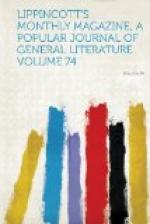Before the middle of the month the continued drain of gold to the United States—the shipment from England of about sixteen millions of dollars having been reported from the beginning of the crisis to the 18th of October—caused the Bank of England to further advance its discount rate to six per cent., and shortly afterward to seven per cent. But, notwithstanding, the price of gold gradually declined to 107-3/4, a lower point than it had touched since 1861. The New York banks meanwhile lost rather than gained strength, and their aggregate of greenbacks under control of the Clearing-house was reduced to less than six millions, although this fact was not published. It was, however, at the same time believed that three or four millions more were distributed among them, of which they made no return to the association. Currency during the latter half of the month began to return somewhat rapidly from the West in the shape of collections by the merchants, and this, in turn, led to remittances to the South, where it was greatly needed for the cotton crop, the movement of which had been almost entirely arrested. Affairs on the Stock Exchange were, in the interval, unsettled, and enormously heavy sacrifices were made in order to adjust differences between brokers, as well as by outside parties in pressing need of cash. On Tuesday, the 14th of October, almost another panic prevailed, and prices touched a lower point than they had before reached. New York Central sold down to 82, Lake Shore to 57-1/2, Western Union to 45, Rock Island to 80-1/2, Pacific Mail to 25, Wabash to 32-3/4, Ohio and Mississippi to 21, Union Pacific to 15-1/2, North-western to 32, St. Paul to 23, St. Paul Preferred to 50, and Harlem to 100, while the feeling of the street was worse than at any time during the crisis; but a quick recovery took place from the extreme point of depression, and the resumption of greenback payments by the Cincinnati banks, following that of the Chicago banks, led to an improved feeling in both financial and commercial circles. The National Trust Company of New York also, about the same time, resumed payment. It was noticeable, however, that little or none of the money reported by the express companies as coming from the West was received by the New York banks—a natural result of their suspension of currency payments, which virtually forced individuals and corporations to be their own bankers. The banks had ceased to perform this function: they were utterly unable to maintain their reserve, cash cheques or discount commercial paper for their customers, and so far the National banking system had failed.




